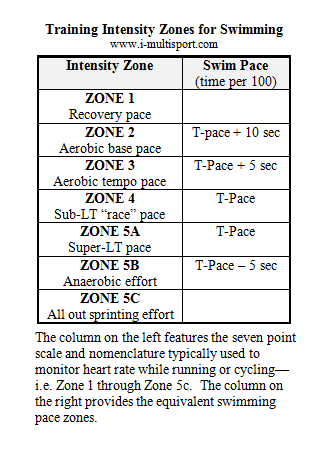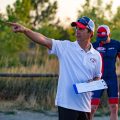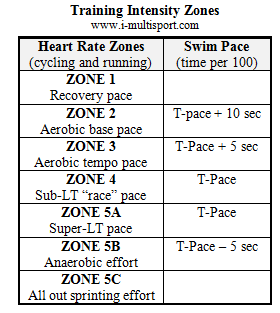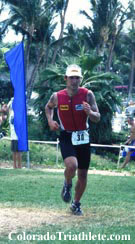February 8, 2010 (Boulder, CO) – Any triathlete with limited time understands the value of making every workout count. This means monitoring not just training volume, but training intensity. Although many triathletes use heart rate monitors while running and/or power meters while cycling, this same equipment is impractical while swimming. So how can you effectively monitor your training intensity in the pool? The simplest answer is to turn to the tried and true pace clock or stopwatch. But effective use of the pace clock first requires determining your training pace zones.
To determine your pace zones, we first need to find your lactate threshold pace—i.e., what is commonly called your “T-pace.” Think of the lactate threshold as the dividing line between aerobic and anaerobic effort. Importantly, this is your “race pace” for sprint distance triathlons and (for experienced racers) Olympic distance events.

The easiest way to find your T-pace is to swim a 1,000-yd or 1,000-m time trial (TT) at a race-level effort. This means you should go into the TT well rested and ready to give it your all. Record your time for the TT and then divide that time by ten to find your pace per 100. Write this number in the table where it says “T-pace.” From there, calculate your pace in the other cells of the right column by adding or subtracting the number of seconds indicated.
For example, let’s say John swims a 1,000-yd TT in 15 minutes. This translates into a pace per 100 yards of 1:30. This would be the pace he would swim for sets targeting Zones 4-5a. For sets targeting Zone 3, his pace would be 1:35 per 100. His pace would be 1:40 for Zone 2, and 1:25 for Zone 5b.
Note that Zone 1 doesn’t have a specific pace. Zone 1 is an easy effort and is used for warming up/cooling down and recovery between harder sets. Zone 5c also doesn’t have a specific pace. Zone 5c corresponds to all out sprinting efforts of short distances where pace is irrelevant.
Keep in mind that for the calculations of your swimming pace zones to be accurate, the results of the TT need to represent a race-level effort. In my experience coaching swimmers of different levels, I have found that a 500 TT often works better for those swimmers who are unaccustomed to “racing” longer distances. In such cases, you can find your pace per 100 based on the results of a 500 TT.
Once you’ve determined your training zones, then you will have a way to gauge the intensity level at which you’re swimming. This will allow you to better pinpoint your workouts to achieve particular training effects.






